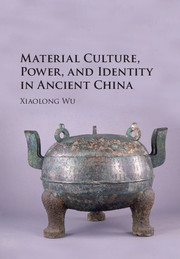Book contents
- Frontmatter
- Dedication
- Contents
- List of Figures
- List of Maps
- List of Tables
- Acknowledgments
- INTRODUCTION
- 1 HISTORICAL SETTING AND APPROACHES TO THE STUDY OF AN ANCIENT STATE IN WARRING STATES CHINA
- 2 LIFE, DEATH, AND IDENTITY IN ZHONGSHAN: SORTING OUT THE ARCHAEOLOGICAL EVIDENCE
- 3 ROYAL MORTUARY PRACTICE AND ARTIFACTS: HYBRIDITY, IDENTITY, AND POWER
- 4 INTERSTATE POLITICS AND ARTISTIC INNOVATION DURING THE REIGN OF KING CUO
- 5 STATECRAFT AND ZHONGSHAN BRONZE INSCRIPTIONS
- 6 FUNERARY ARCHITECTURE, KINGLY POWER, AND COURT POLITICS
- CONCLUSION
- Appendices
- Notes
- Bibliography
- Index
4 - INTERSTATE POLITICS AND ARTISTIC INNOVATION DURING THE REIGN OF KING CUO
Published online by Cambridge University Press: 23 March 2017
- Frontmatter
- Dedication
- Contents
- List of Figures
- List of Maps
- List of Tables
- Acknowledgments
- INTRODUCTION
- 1 HISTORICAL SETTING AND APPROACHES TO THE STUDY OF AN ANCIENT STATE IN WARRING STATES CHINA
- 2 LIFE, DEATH, AND IDENTITY IN ZHONGSHAN: SORTING OUT THE ARCHAEOLOGICAL EVIDENCE
- 3 ROYAL MORTUARY PRACTICE AND ARTIFACTS: HYBRIDITY, IDENTITY, AND POWER
- 4 INTERSTATE POLITICS AND ARTISTIC INNOVATION DURING THE REIGN OF KING CUO
- 5 STATECRAFT AND ZHONGSHAN BRONZE INSCRIPTIONS
- 6 FUNERARY ARCHITECTURE, KINGLY POWER, AND COURT POLITICS
- CONCLUSION
- Appendices
- Notes
- Bibliography
- Index
Summary
THE TOMB OF KING CUO YIELDED SEVERAL HUNDRED BRONZE ARTIFACTS, including ritual vessels, daily utensils, horse and chariot fittings, weapons, bronze components of wooden or lacquer items, and tent skeletons. Many of these bronzes, especially the ones with elaborate designs, have cast or engraved inscriptions on their surfaces that record the year of their production and the names of the workshop, overseer, and artisan responsible for their manufacture. After arranging the dated bronzes into chronological order and observing the changes of their type and style over time, we can clearly see that the artistic style of these bronzes changed dramatically during the fourteenth year of King Cuo's reign, the year in which the state of Zhongshan achieved a great military success against a rival state, the Yan. New metallurgical technologies were applied and new motifs were introduced into the iconographic vocabulary of the Zhongshan bronzes. The relevant historical, archaeological, and paleographical evidence, when viewed together, suggests that these stylistic changes were related to Cuo's invasion of Yan, an important historical event revealed by the Cuo bronze inscriptions. Viewed under the context of the precise historical moment, stylistic changes and technological innovations can be seen to have had political significance.
“WORKSHOP INSCRIPTIONS” AND THE ZHONGSHAN SYSTEM OF BRONZE MANUFACTURE
The Kaogongji 考工記 chapter of the Zhouli indicates that official workshops during the Warring States Period were systematically organized; with artisans and supervisors of different ranks, they were sophisticated in division of labor and technological co-ordination. Casting or engraving “workshop inscriptions” or information concerning the manufacture of an artifact on its surface was common practice in the official bronze workshops of the Warring States Period. For instance, inscriptions recording production information were found on bronzes from the states of Qi and Jin. These workshop inscriptions were added to bronzes for supervisory purposes in an effort to guarantee the quality of final products. The contents of these inscriptions, as well as the titles for overseers and artisans, vary in each state. The “workshop inscriptions” on Cuo's bronzes specify the year of the king's reign, the workshop unit, the title and name of the overseer (sefu 嗇夫), and the title and name of the artisan (gong 工). In some cases the weight of the completed artifact was also included.
- Type
- Chapter
- Information
- Material Culture, Power, and Identity in Ancient China , pp. 134 - 148Publisher: Cambridge University PressPrint publication year: 2017



